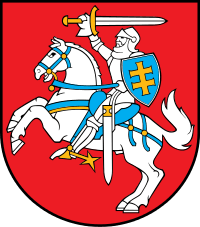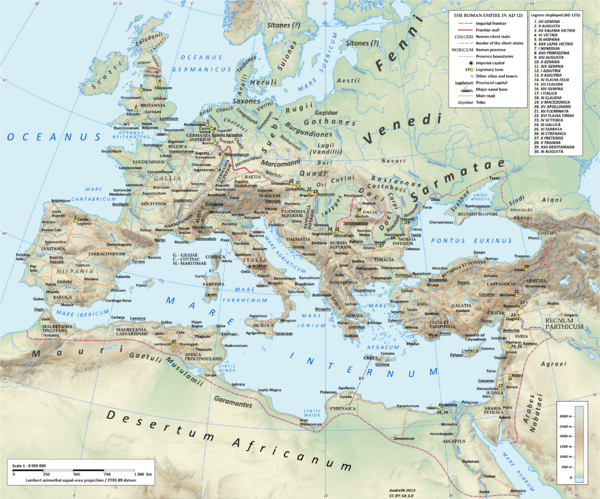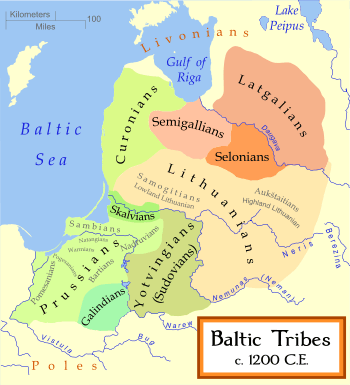Aesti
Part of a series on the |
|---|
| History of Lithuania |
 |
| Chronology |
|
|
Part of a series on the |
|---|
| History of Estonia |
 |
|
Viking and Middle ages |
| Chronology |
|
|
The Aesti (also Aestii or Aests) were an ancient people first described by the Roman historian Tacitus in his treatise Germania (circa 98 CE).[1] According to Tacitus, Aestui, the land of the Aesti, was located somewhere east of the Suiones (Swedes) and west of the Sitones (possibly the Kvens), on the Suebian (Baltic) Sea. This and other evidence suggests that Aestui was in or near the present-day Russian enclave of Kaliningrad Oblast (previously East Prussia).
Despite the phonological similarity between Aestui and the modern ethnonyms of Estonia, especially in popular etymologies, the two geographical areas are not contiguous and there are few, if any, direct historical links between them.
Overview
Geographical and linguistic evidence suggests that the Aesti were, ethnologically, a Baltic people. They may have been synonymous with the Brus/Prūsa or "Old Prussians" – that is, not a Germanic people like modern Prussians, and not a Finno-Ugric people, such as modern Estonians. Tacitus almost certainly erred in implying that the Aesti were a hybrid Celtic-Germanic culture: he claimed that while the "Aestian nations" followed the "same customs and attire" as "the Suebians" (at the time a collective term for eastern Germanic peoples), their speech resembled that of the Britons (i.e., a Celtic language rather than the Germanic languages of the Suebii). Tacitus often utilised unreliable, secondary sources,[2] and may not have been aware of such distinctions in any case.
Tacitus' mention of a cult of the mother of the gods among the Aesti along the eastern Baltic coast does apply to the ancient Estonian and Baltic pagan religions.[3] He also refers to the Fenni living next to the Aesti—the Fenni being ancestors to the Finns or the Sámi would situate them closest to the Estonians. Ultimately, Tacitus' use of Aesti could apply equally well to either a specific people or to a grouping of ethnically diverse peoples across a wider area .[3]
In the modern Estonian language, Eesti is the endonym for "Estonia". Estonia was known as Estia or Hestia in some early Latin sources, and Eistland in ancient Scandinavian sagas. Estonians themselves used Maarahvas, meaning people of the land, to refer to themselves until the early modern era. The etymologies of Aesti and Eesti remain subjects of scholarly conjecture.
Tacitus is also credited with recording the only surviving example of the Aestian language: glesum, an apparently Latinised word for amber and similar to the later Latvian equivalent: glīsas. Both may be loanwords from a Germanic language, given their similarity to the Gothic word glas.[4]
There is evidence that the area around the Vistula Lagoon was strongly associated with the Aesti: the Old Prussian and modern Lithuanian names for the lagoon, Aīstinmari and Aistmarės respectively, appear to be derived from Aesti and mari ("lagoon" or "fresh water bay").[5] Therefore, the oldest known name of the body of the water was "lagoon of the Aesti".

Historical sources
Tacitus

The ancient writers, beginning with Tacitus, who was the first Roman author to mention them in his Germania, provide very little information on the Aestii.[6] Although Tacitus never travelled to Magna Germania himself and only recorded information he had obtained from others, the short ethnographic excursus below is the most detailed ancient account of the Aestii that we have:
- Upon the right of the Suebian Sea the Aestian nations reside, who use the same customs and attire with the Suebians; their language more resembles that of Britain. They worship the Mother of the Gods. As the characteristic of their national superstition, they wear the images of wild boars. This alone serves them for arms, this is the safeguard of all, and by this every worshipper of the Goddess is secured even amidst his foes. Rare amongst them is the use of weapons of iron, but frequent that of clubs. In producing of grain and the other fruits of the earth, they labour with more assiduity and patience than is suitable to the usual laziness of Germans. Nay, they even search the deep, and of all the rest are the only people who gather amber. They call it glesum, and find it amongst the shallows and upon the very shore. But, according to the ordinary incuriosity and ignorance of Barbarians, they have neither learnt, nor do they inquire, what is its nature, or from what cause it is produced. In truth it lay long neglected amongst the other gross discharges of the sea; till from our luxury, it gained a name and value. To themselves it is of no use: they gather it rough, they expose it in pieces coarse and unpolished, and for it receive a price with wonder. (Germania, chapter XLV).
The placement of the Tacitean Aestii is based primarily on their association with amber, a popular luxury item during the life of Tacitus, with known sources at the southeastern coast of the Baltic Sea. The Baltic amber trade, which appears to have extended to the Mediterranean Sea, has been traced by archaeologists back to the Nordic Bronze Age; its major center was located in the region of Sambia.
This trade probably existed prior to the historical Trojan War in the 13th century BCE, as amber is one of the substances in which the palace of Menelaus at Sparta was said to be rich in Homer's The Iliad.[7]
Cassiodorus

Cassiodorus' Variae, published in 537, contains a letter written by Cassiodorus in the name of Theodoric the Great, addressed to the Aesti:
- It is gratifying to us to know that you have heard of our fame, and have sent ambassadors who have passed through so many strange nations to seek our friendship.
We have received the amber which you have sent us. You say that you gather this lightest of all substances from the shores of ocean, but now it comes thither you know not. But as an author named Cornelius (Tacitus) informs us, it is gathered in the innermost islands of the ocean, being formed originally of the juice of a tree (whence its name succinum), and gradually hardened by the heat of the sun. Thus it becomes an exuded metal, a transparent softness, sometimes blushing with the color of saffron, sometimes glowing with flame-like clearness. Then, gliding down to the margin of sea, and further purified by the rolling of the tides, it is at length transported to your shores to be cast upon them. We have thought it better to point this out to you, lest you should imagine that your supposed secrets have escaped our knowledge. We sent you some presents by our ambassadors, and shall be glad to receive further visits from you by the road which you have thus opened up, and to show you future favors.
The style of the letter proves that the nation was at that time independent, not ruled by the Ostrogoths. Apparently Cassiodorus considered it politically essential to establish friendly relations with the Nordic region. The letter also indicates that the Aesti were fully confident of the value of amber and had made out of it a trade secret. The sending of presents and the promise to show future favors were in ancient times a cordial way of giving de jure recognition to another power.[8]
Jordanes

Sixth Century historian Jordanes makes two references the Aesti in his book "The Origins and the Deeds of the Goths", which was a treatment of Cassiodorus' longer book (which no longer survives) on the history of the Goths. The first quote places the Aestii beyond the Vidivarii, on the shore of the Baltic: "a subject race, likewise hold the shore of Ocean." The next quote concerns the subjugation of the Aesti by Hermanaric, king of the Gothic Greuthungi: "This ruler also subdued by his wisdom and might the race of the Aesti, who dwell on the farthest shore of the German Ocean".
Alfred the Great
In an 11th-century manuscript of King Alfred's account of the voyage from Hedeby to Truso by Wulfstan, held by the British Museum, includes ethnographic information on the medieval Aestii,[9][10] in the which the terms Esti,Est-mere and Eastland are used. In the text, a summary description of the country and its riches is followed by a very detailed account of the people's funeral customs.
Adam of Bremen
During the 11th Century Adam of Bremen, citing Einhard (who in the Vita Caroli Magni states "the Slavs and the Aisti live on the shores of the Eastern Sea"), denotes the coastal tribe as the Haisti and refers to today's Estonia as Aestland.[11]
Notes
- ↑ Tacitus, Germania, Germania.XLV
- ↑ E. J. Kenney, The Cambridge History of Classical Literature: Volume 2, Latin Literature, Cambridge, Cambridge University Press, pp. 647–8.
- 1 2 Lang, Valter. The Bronze And Early Iron Ages In Estonia, Estonian Archaeology 3. University of Tartu Press, Tartu. 2007. retrieved at 26 December 2013
- ↑ Rübekeil, Ludwig. Suebica - Völkernamen und Ethnos Innsbruck, 1992. p. 72f.
- ↑ Mikkels Klussis, Dictionary of Revived Prussian: Prussian - English, English - Prussian, Vilnius 2005–06, p. 47.
- ↑ For a theory that the Aestii are the Osismii of Strabo and the Ostimii of Pytheas also mentioned by Strabo, see Bojtàr, Endre (1999). Foreword to the Past: a Cultural History of the Baltic People. Central European University Press. p. 104. ISBN 963-9116-42-4. This is not a majority view as there is evidence of the continuity of the Osismii in France.
- ↑ Lillian Feder (1964), Crowell's Handbook of Classical Literature, p. 192. USA: Crowell.
- ↑ Edgar V. Saks. Aestii. p. 52–53.
- ↑ Kemp Malone, On King Alfred's Geographical Treatise, Speculum, Vol. 8, No. 1. (Jan., 1933), pp. 67-78
- ↑ Samuel H. Cross, Notes on King Alfred's North: Osti, Este, Speculum, Vol. 6, No. 2. (Apr., 1931), pp. 296-299
- ↑ Endre Bojtár, Foreword to the past: a cultural history of the Baltic people, Central European University Press, 1999, p106
References
- Deutschler, Yorck: "Die Aestii - Bezeichnung für die heutigen Esten Estlands oder die untergegangenen Pruzzen Ostpreußens" , in: Deutschler, Yorck, "Die Singende Revolution" - Chronik der Estnischen Freiheitsbewegung (1987-1991), pp. 196–198. Ingelheim, March 1998/June 2000. ISBN 3-88758-077-X
- Saks, Edgar Valter (1960). Aestii, An Analysis of an Ancient European Civilization. Studies in the Ur-European History". Part 1. Montreal–Heidelberg: Võitleja. link

